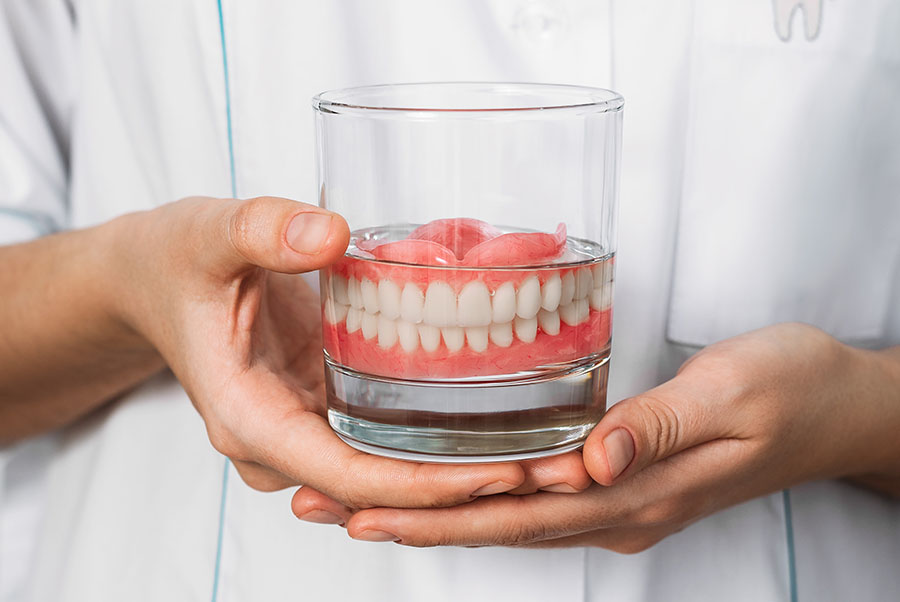

Dental prosthetics
Dental prosthetics is a branch of dental medicine which deals with the replacement of lost teeth and soft parts of the oral cavity with complete (total) or partial dentures, crowns, bridges and veneers.
Dental prosthetics is divided into mobile prosthetics and fixed prosthetics.
Dental veneers
Dental veneers are individually made of ceramics, zirconia ceramics or composite veneers, which are cemented on a specially flattened and prepared front surface of the tooth in order to correct the cosmetic irregularities (color, shape, position).
Veneers are minimally invasive prosthetic (cosmetic) supplements, which are used to remove up to 1mm of the front tooth enamel. Veneers are indicated in cases where we want to correct the color, shape, position, size of the tooth, and they are used to close the gap between the teeth or to compensate for the broken sides and edges.
Dental crowns and bridges
Dental crowns (dental casing) and dental bridges are individual prosthetic implants used for cosmetic and functional reconstruction. Lack of tooth can lead to pathological changes in the bite, movement and tilting of the tooth, damage of the temporomandibular joint, development periodontal diseases and the formation of new cavity. That is why artificial teeth are used.
Metal-ceramic crowns/bridges
The metal-ceramic crowns are all crowns for which the base is made of metal and the outer visible layer of ceramics. As the base for the metal-ceramic crowns, the most commonly used materials are cobalt-chromium alloys or, if necessary, gold.
Thus, there is metal-ceramics and dental gold-ceramics
Non-metallic ceramic crowns
Non-metallic dental crowns are at the peak of modern dentistry and in the last couple of years have become the standard for highly cosmetic restoration works and works in the front part of the jaw. The best results are visible when the crown is placed on a naturally polished tooth.
Dentures
In cases where it is not possible to incorporate fixed prosthetic substitutions for various reasons, mobile prosthetics offers an adequate solution.
Mobile prosthetics is any work that a patient can independently remove from their mouth
Mobile dentures can be complete (total) dentures or partial dentures. Complete dentures can be anchored on implants.
The advantage of mobile prosthetic works is certainly their affordable price and simplicity of production.
Complete (total) denture
Complete denture replaces the lack of teeth and tissue in cases of complete anodontia. In case that the patient has to have a few remaining teeth removed, the immediate (temporary) denture is produced first, which is worn until the tissue has healed and the jaw is completely formed.
The basic disadvantage in comparison with the fixed and semi-fixed solutions is further deterioration of the dental bone in the jaw. An additional problem is the lack of an element for which the denture can at least be slightly fixed which will increase its instability. In this case, the only stability for the denture can be an artificial palate which will create a vacuum between the artificial and the natural palate. Adjusting to this kind of mobile denture (artificial teeth) is slow and as a result it can cause a frequent feeling of discomfort or vomiting reflex, and impeded speech.
Partial denture
Partial dentures are used to substitute multiple teeth in case if it is impossible to create a bridge. Partial denture is used when a patient lacks several teeth, but not all of them.
It is used as a solution when there is no possibility of creating a bridge or incorporating dental implants, and when a patient wants a more economic, i.e. cheaper prosthetic substitution.
The denture can be entirely made of acrylates, but a metal skeleton is recommended, on which the artificial tissue and teeth are placed. This denture is fixed with clips for healthy teeth.
Today we are able to produce the so-called flexible partial dentures with tooth-colored clips.
They are more comfortable to wear and the metal clips, which are used to fix the denture, are replaced by elastic clips in the color of the tooth, making them cosmetically more acceptable
Partial denture with attachments
The partial denture can be attached to the teeth by means of a crown attachment which is usually located on the last tooth.
Unlike ordinary partial denture, this is a much more precise denture, with less stress on the natural teeth, and it is cosmetically more acceptable.
Implant dentures
Implant dentures, as the name suggests, are dentures attached to the dental implants. Dental implants are incorporated in the jaw and are upgraded with special anchors which later hold the denture.
In order to produce a denture on the upper jaw implants, 4 implants are required, and 2 are a minimum for the lower jaw.
THE BENEFITS OF SEMI-FIXED PROSTHETICS
Due to loss of all teeth, the resorption, i.e. decay of the jaw bone occurs.
Aside from saving the jaw bone by using the semi-fixed prosthetics, the subject work will offer great stability and enhance the feeling of safety which no mobile work can offer. By its definition, semi-fixed prosthetic works are all works which are placed on dental implants regardless of how they are fixed to them.
